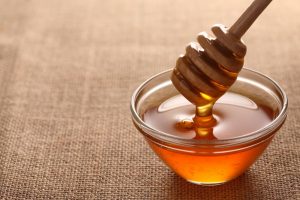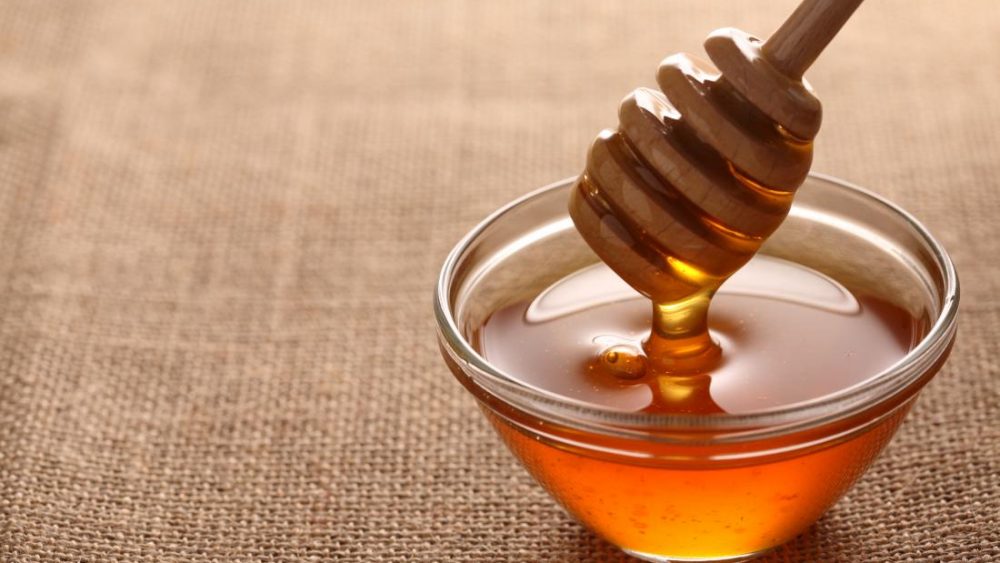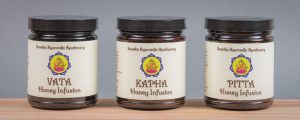 Honey is considered amrita or healing nectar in the eyes of Ayurveda. With its long list of health benefits and unparalleled healing potential, honey has been used as both food and medicine for thousands of years. However, just as with any substance, it has the power to heal as well as harm depending on how it is used. Therefore, knowing the best methods to take this healing nectar and when to avoid it are essential!
Honey is considered amrita or healing nectar in the eyes of Ayurveda. With its long list of health benefits and unparalleled healing potential, honey has been used as both food and medicine for thousands of years. However, just as with any substance, it has the power to heal as well as harm depending on how it is used. Therefore, knowing the best methods to take this healing nectar and when to avoid it are essential!
Overall Health Benefits of Honey (when used properly)
- Naturally antibacterial
- Contains vital antioxidants and enzymes
- Increases the digestive fire
- Scrapes away toxins, fat, and cholesterol (known as lekhana)
- Aids in weight loss
- Removes congestion
- Reduces Kapha dosha
- Alleviates hoarseness of voice
- Soothes a sore throat
- Relieves cough
- Promotes rejuvenation
- Enhances the potency of other herbs when taken together (known as Yoga Vahi)
- Heals wounds and burns when applied externally (great with turmeric!)
As you can see, honey is a much healthier option than using refined sugar or even cane sugar. Honey is high in vital enzymes and antioxidants and possesses a wealth of health benefits, allowing it to go beyond the “empty calorie” label that is true for many sweeteners. Needless to say, however, too much of a good thing will negate any potential goodness it may bring. Therefore, no matter what your purpose for taking honey is, it must still be used in moderation. With this in mind, here are some of the essential Ayurvedic honey rules that will help you make the most of this sweet nectar while avoiding any toxicity that it can cause.
The 6 Essential Honey Rules of Ayurveda
1. Never heat honey!
Although the exact temperature is debatable, it is clearly written in the ancient Ayurvedic texts that honey, when heated, is a direct cause of creating toxins in the system. During the heating process, the honey undergoes chemical transformation as it becomes a glue-like, homogenized substance. This sludge-like substance is now unrecognizable to the body, hard-to-digest and extremely congestive to the GI tract and other vital channels of the body.
A good general rule for this is to avoid heating honey over 108 degrees. This means that you can still use honey in your tea; however, the tea should be at a drinkable temperature before you add it. Since you may not have a thermometer handy when making tea, the best way to avoid overheating the honey will be to perform the very official “pinky test”. This simply involves placing your pinky finger into the warm tea and holding it there for at least 10 seconds. If you are able to keep it in the tea comfortably for this extended amount of time, then the honey should be safe to be added.
Other vital areas to avoid will be consuming any baked goods (e.g. bread, granola, cereal, cookies, bars, etc), cooked food, marinades, or heated recipes that use honey as an ingredient. If you are adding honey to your porridge or oatmeal, once again, the food must be cooled to under 108 degrees before mixing it in. Taking these essential steps will keep the healing powers of the honey strong and allow you to avoid unknowingly creating toxicity in your system.
2. Never take honey and ghee together in equal proportions by WEIGHT (not volume).
This is another often unknown honey rule that has been generously shared with us from the ancient rishis of Ayurveda. It is clearly stated in the classical Ayurvedic texts that taking ghee with honey in equal proportions by weight (e.g. 1 gram of honey to 1 gram of ghee) transforms them from healing substances to congestive toxic sludge as they go through the digestive process.
Since honey is naturally heavier in weight than ghee, taking ghee and honey in equal proportion by volume (e.g. 1 tsp of honey with 1 tsp of ghee) will ensure the weights are unequal and the combination is safe to take in. If you are taking more ghee with less honey, however, you will likely need to get a weight before consuming this mixture to avoid creating potential toxicity.
3. Honey should be avoided by Pitta types or by those with a Pitta imbalance.
The sweet taste may be considered cooling in Ayurveda, but honey itself is heating. This means that Pitta types or those with a Pitta imbalance (hyperacidity, eczema, psoriasis, rash, etc) should avoid using honey, especially regularly or in larger amounts. Some more suitable natural sweeteners that are cooling and therefore will reduce Pitta are maple syrup, dates, date sugar, or coconut sugar.
Please note that although honey is heating, it can often be used in small amounts by Pitta types if their Pitta is in balance. If overused or misused, however, it definitely will create excessive heat in the system, increasing Pitta and worsening any current Pitta imbalances that are present.
4. Honey is a great option for Kapha types, Kapha imbalances, weight loss, and detoxification.
One of the main qualities honey possesses is known as lekhana, or its ability to scrape away accumulation in the system. Because of this, honey is considered a great medicine for Kapha types or anyone with a Kapha imbalance. Honey is often recommended to aid in weight loss, reduce high cholesterol levels, stimulate a sluggish digestion (manda agni), remove congestion, and unclog the vital channels of the body.
In order to be effective, honey must be taken in moderate dosages* (1/2-1 tsp) and taken in the proper context. For example, taking 1 tsp of honey in warm water with several drops of apple cider vinegar or lime juice is a great way to enhance one’s digestion and metabolism, detoxify the system, and promote weight loss. This should be taken first thing in the morning on an empty stomach and again 30 minutes before each meal.
*As a general rule, it is recommended to avoid taking over 3 tsp of honey daily for these purposes.
5. Take honey with herbs to enhance their potency.
Honey possesses another unique quality known as Yoga Vahi that allows it to enhance the healing properties of other substances when taken together. This is due to the fact that honey acts as a vehicle (known as anupan) of sorts that will take the herb directly into the bloodstream and allow it to penetrate deeper into the vital tissues of the body.
For this purpose, one tsp of honey can be mixed in warm water and used as a medium for any powdered herb, herbal tincture, or herbal formula. Alternatively, one can mix an herb directly with the honey to make a paste and follow with a few sips of warm water. Another method is to take an herbal syrup or elixir that has been infused with honey. Steeping herbs or spices directly into honey for a prolonged amount of time is a very effective way to utilize this unique quality as well.
6. Take honey with ghee (not in equal weight) to promote energy, rejuvenation, and longevity.
Taking honey with ghee* is considered a healing ambrosia with powerful health benefits. Although these substances are very healing on their own, when taken properly in combination, they can become much more healing still. The most notable effects of this tasty mixture include increasing energy, enhancing cellular rejuvenation, and promoting a long, healthy, happy life.
*Always avoid taking ghee and honey in equal amounts by weight!
General Directions: Blend 1 tsp of honey with 1 tsp of ghee to form a paste. Take this 1-2 times daily after meals or anytime a pick-me-up is needed. Wash down with a few sips of warm water.




Hi Danielle,
Thank you so much for making this amazing website with so many informative articles. I wanted to ask is it ok to drink warm lemon and honey water before oil pulling. And after drinking this water after how long you can drink chai (tea with milk ).
Thank you so much
Thank you, Danielle! I go to your website frequently looking for recipes or other information. I am a pitta-kapha. I often tend towards a Kapha imbalance, but I have also experienced the Pitta imbalance too.
I love your recipes and food list. I have learned many valuable health tips from your website and articles.
Warmest Wishes, Sydney
Hi Sydney,
Thank you for taking the time to write in! I am so happy you are enjoying the site and finding it useful. Feel free to write in any time if questions come up. I am always happy to help:)
Be well!
Namaste,
Danielle